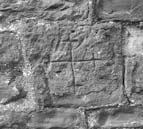Select a site alphabetically from the choices shown in the box below. Alternatively, browse sculptural examples using the Forward/Back buttons.
Chapters for this volume, along with copies of original in-text images, are available here.
Object type: Panel with incised cross
Measurements: H. 25.5 cm (10 in); W. 29.5 > 27 cm (11.6 > 10.6 in); D. unknown
Stone type: Pale red-brown (10R 5/4), medium-grained, non-calcareous, clast-supported, sandstone. The sub-angular to sub-rounded quartz grains vary from 0.2 to 0.6 mm across, but are mostly in the range 0.3 to 0.4 mm. Brownstones Formation? (Lower Old Red Sandstone Group, Old Red Sandstone Super Group), early Devonian.
Plate numbers in printed volume: Ill. 532
Corpus volume reference: Vol 10 p. 295-6
(There may be more views or larger images available for this item. Click on the thumbnail image to view.)
Described and illustrated by Watkins (1918–20, 207); according to Marshall (1927–9, 101), the church had been whitewashed and/or plastered until a fairly recent date. The stone was probably built into the wall at the time of its construction in the thirteenth century.
Incised cross on stone panel. The equal-armed cross is quite deeply incised and has crosslets carved at the end of each arm. This stone may be set upside down, with the taper originally widening from top to bottom.
Appendix A item (stones dating from Saxo-Norman overlap period or of uncertain date)
This and Garway 2 have been entered as uncertain (Dubia 12) in the Welsh Corpus South-East volume, partly as a result of research into the techniques used (pecking and scoring) to create incised designs (Redknap and Lewis 2007, 122–4, 555–6). The present author is also unsure. Some of the crosses in the walls of this church are clearly later, but nos. 1 and 2 are not square but widen from top to bottom (assuming that no. 1 is set upside down). They might, therefore be small grave-markers. The crosses on these two stones are also very similar to seventh-/ninth-century cross-marked stones from Wales, even if the incised crosses are scored rather than pecked. Deeply incised examples that seem to have been scored have been dated seventh to ninth century by Nancy Edwards in Cardiganshire and Pembrokeshire (Edwards 2007, 161–2, cat. CD15 (Llandysul); 162–3, cat. CD17 (Llanfihangel-y-Creuddyn); 332, cat. P23 (Llandeilo)).
As noted by Redknap and Lewis (2007, 556), a possible context for an early date is provided by several texts in the Book of Llandaf referring to a church at and to an abbot of Garway; documents of seventh- and eighth-century date may lie behind these texts (Evans and Rhys 1893, 162, 163–4, 165–6, 192; Davies 1978, 170, 171, 176).



